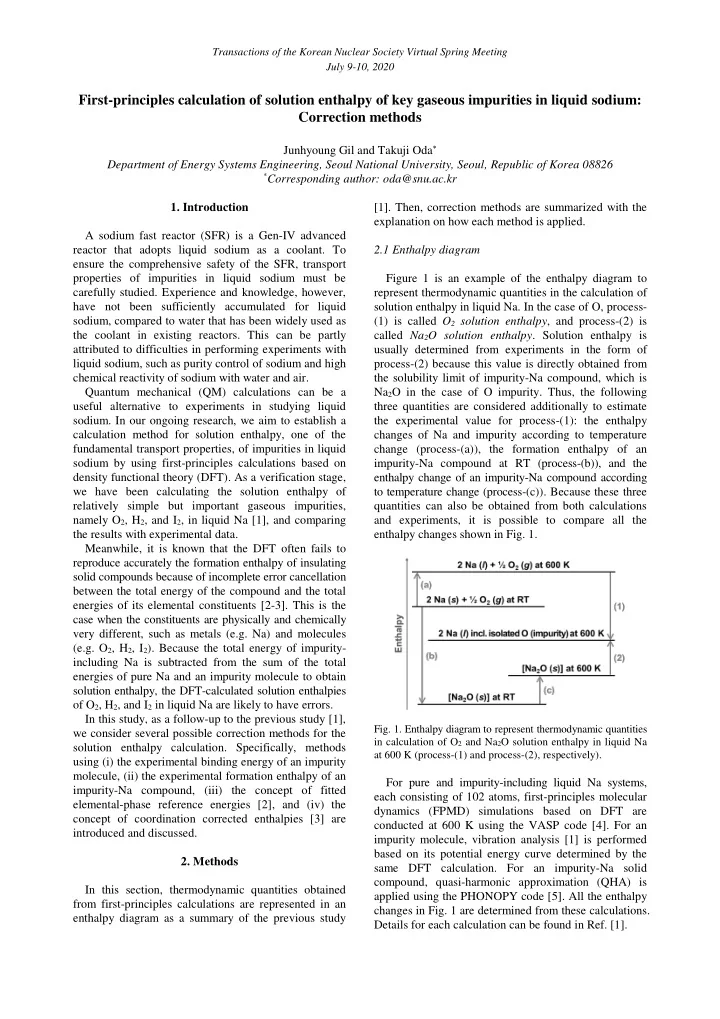

Transactions of the Korean Nuclear Society Virtual Spring Meeting July 9-10, 2020 First-principles calculation of solution enthalpy of key gaseous impurities in liquid sodium: Correction methods Junhyoung Gil and Takuji Oda Department of Energy Systems Engineering, Seoul National University, Seoul, Republic of Korea 08826 * Corresponding author: oda@snu.ac.kr 1. Introduction [1]. Then, correction methods are summarized with the explanation on how each method is applied. A sodium fast reactor (SFR) is a Gen-IV advanced reactor that adopts liquid sodium as a coolant. To 2.1 Enthalpy diagram ensure the comprehensive safety of the SFR, transport properties of impurities in liquid sodium must be Figure 1 is an example of the enthalpy diagram to carefully studied. Experience and knowledge, however, represent thermodynamic quantities in the calculation of have not been sufficiently accumulated for liquid solution enthalpy in liquid Na. In the case of O, process- sodium, compared to water that has been widely used as (1) is called O 2 solution enthalpy , and process-(2) is the coolant in existing reactors. This can be partly called Na 2 O solution enthalpy . Solution enthalpy is attributed to difficulties in performing experiments with usually determined from experiments in the form of liquid sodium, such as purity control of sodium and high process-(2) because this value is directly obtained from chemical reactivity of sodium with water and air. the solubility limit of impurity-Na compound, which is Quantum mechanical (QM) calculations can be a Na 2 O in the case of O impurity. Thus, the following useful alternative to experiments in studying liquid three quantities are considered additionally to estimate sodium. In our ongoing research, we aim to establish a the experimental value for process-(1): the enthalpy calculation method for solution enthalpy, one of the changes of Na and impurity according to temperature fundamental transport properties, of impurities in liquid change (process-(a)), the formation enthalpy of an sodium by using first-principles calculations based on impurity-Na compound at RT (process-(b)), and the density functional theory (DFT). As a verification stage, enthalpy change of an impurity-Na compound according we have been calculating the solution enthalpy of to temperature change (process-(c)). Because these three relatively simple but important gaseous impurities, quantities can also be obtained from both calculations namely O 2 , H 2 , and I 2 , in liquid Na [1], and comparing and experiments, it is possible to compare all the the results with experimental data. enthalpy changes shown in Fig. 1. Meanwhile, it is known that the DFT often fails to reproduce accurately the formation enthalpy of insulating solid compounds because of incomplete error cancellation between the total energy of the compound and the total energies of its elemental constituents [2-3]. This is the case when the constituents are physically and chemically very different, such as metals (e.g. Na) and molecules (e.g. O 2 , H 2 , I 2 ). Because the total energy of impurity- including Na is subtracted from the sum of the total energies of pure Na and an impurity molecule to obtain solution enthalpy, the DFT-calculated solution enthalpies of O 2 , H 2 , and I 2 in liquid Na are likely to have errors. In this study, as a follow-up to the previous study [1], Fig. 1. Enthalpy diagram to represent thermodynamic quantities we consider several possible correction methods for the in calculation of O 2 and Na 2 O solution enthalpy in liquid Na solution enthalpy calculation. Specifically, methods at 600 K (process-(1) and process-(2), respectively). using (i) the experimental binding energy of an impurity molecule, (ii) the experimental formation enthalpy of an For pure and impurity-including liquid Na systems, impurity-Na compound, (iii) the concept of fitted each consisting of 102 atoms, first-principles molecular elemental-phase reference energies [2], and (iv) the dynamics (FPMD) simulations based on DFT are concept of coordination corrected enthalpies [3] are conducted at 600 K using the VASP code [4]. For an introduced and discussed. impurity molecule, vibration analysis [1] is performed based on its potential energy curve determined by the 2. Methods same DFT calculation. For an impurity-Na solid compound, quasi-harmonic approximation (QHA) is In this section, thermodynamic quantities obtained applied using the PHONOPY code [5]. All the enthalpy from first-principles calculations are represented in an changes in Fig. 1 are determined from these calculations. enthalpy diagram as a summary of the previous study Details for each calculation can be found in Ref. [1].
Recommend
More recommend